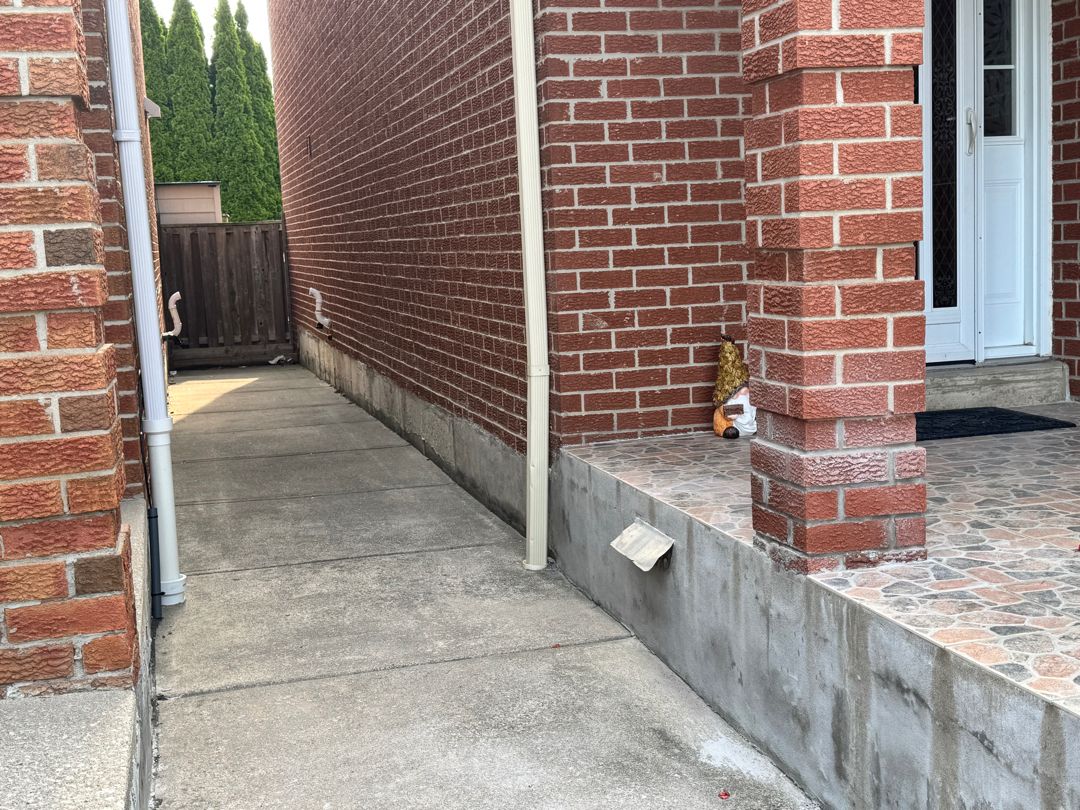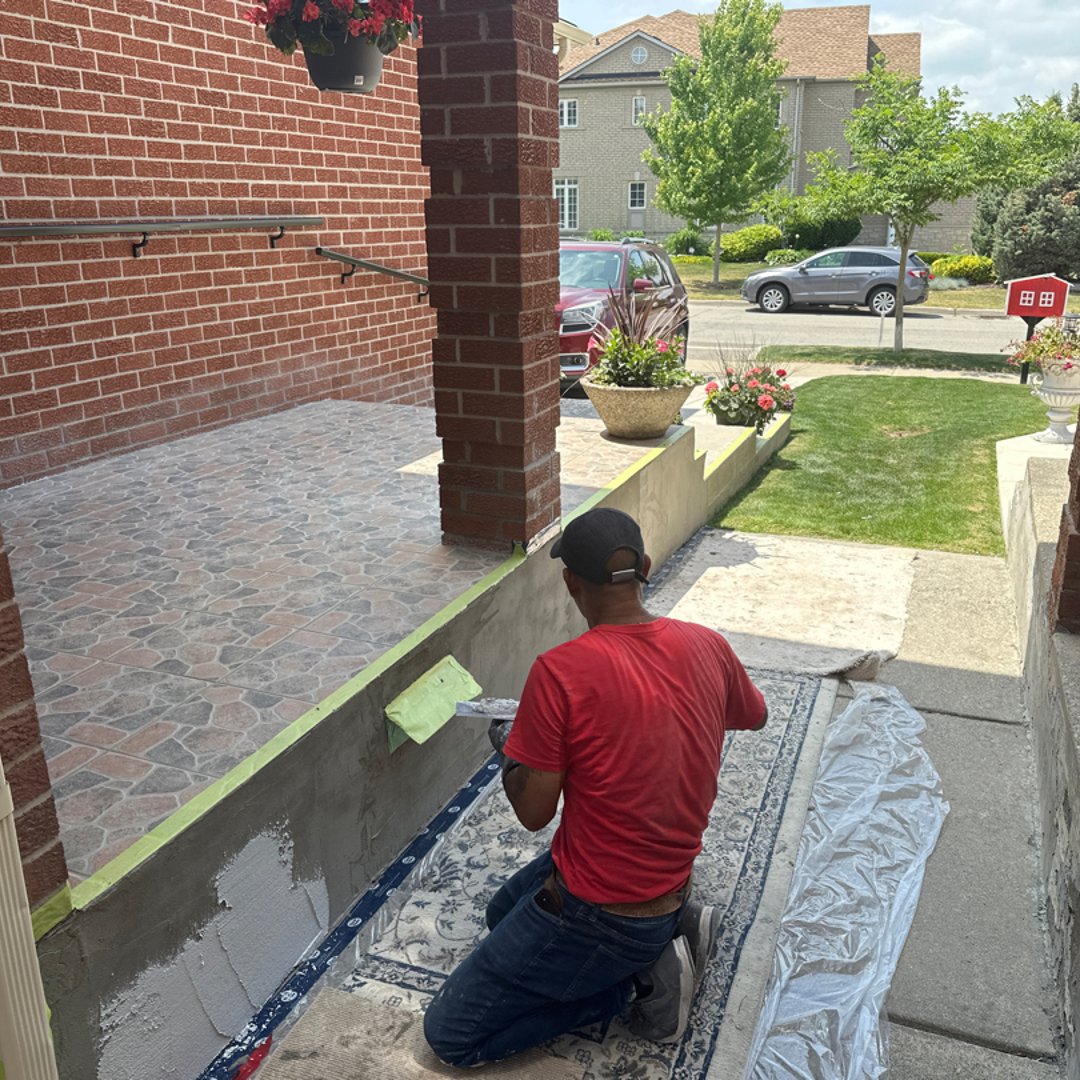
We Assess the Problem
We inspect the damage, identify what caused it, and plan the fix. No shortcuts—just a clear path to doing it right.


Period-appropriate restorations across Ontario. Swipe to see more photos.






Door and window openings filled with orange reclaimed brick and lime-based mortar.






Complete mortar joint replacement through chimney with new concrete sill caps.
Brick damage doesn't fix itself. Spot these warning signs early to avoid expensive repairs later.
Hard cement traps moisture in soft historic brick—when it freezes, brick faces blow off. This spreads to surrounding bricks unless cement is removed and replaced with breathable lime mortar.
Original lime mortar weathers naturally over 80-100 years, leaving recessed or missing joints. Water penetrates these gaps, causing interior moisture damage and freeze-thaw cycles in brick.
White chalky deposits on heritage brick indicate water passing through the wall, carrying salts to the surface. This signals failed mortar joints or incompatible modern repairs trapping moisture.
Seeing any of these? Get a free assessment.
Heritage masonry restoration repairs and conserves historic buildings using period-appropriate materials and traditional techniques that respect the original construction.
Historic masonry was built differently—soft lime mortar, handmade brick, and construction methods that allow buildings to breathe and move. Modern repair methods can actually accelerate damage if they are not compatible.
Designated heritage building
Municipal or provincial heritage designation requires appropriate methods.
Pre-1920s construction
Buildings from this era typically used lime mortar, not Portland cement.
Previous repair failures
Spalling or deterioration after modern repairs signals compatibility issues.
Different brick problems call for different repairs. We look at the damage and recommend the lightest fix that actually solves it—nothing more, nothing less.
Remove deteriorated or inappropriate mortar and replace with lime-based mortar matched to original colour and composition.
Source and install period-appropriate brick to replace damaged units, matching size, colour, and texture.
Repair damaged limestone, sandstone, or granite using compatible mortars and proven conservation techniques.
Repair or replicate cornices, window hoods, belt courses, and other architectural details.
Not sure which service you need?
Protect character, value, and building longevity
Appropriate restoration maintains the historic appearance and architectural significance that makes your building special.
Compatible materials stop the cycle of deterioration caused by inappropriate modern repairs.
Proper methods and documentation satisfy municipal heritage committees and provincial requirements.
Heritage properties command premium values when properly maintained. Poor repairs reduce value.
Historic buildings were built to last centuries. Appropriate care ensures they continue to stand.
Our Process
Transparent process, quality results. Here's what to expect.

We inspect the damage, identify what caused it, and plan the fix. No shortcuts—just a clear path to doing it right.

Clean prep, proper materials, careful execution. We're detail-oriented because the small stuff determines how long the work lasts.

Repairs that blend in, a site you'd never know we touched, and a warranty you can count on.
Clear documentation of what's included in every project
We let you know when we're coming, what we're doing, and when we're done
We review the finished work together before sign-off
Ready to get started? Book a free on-site estimate.
Schedule EstimateBrick and mortar matching so seamless, you can't tell where we worked.
Same trained team on every job. No middlemen, no surprises.
Drop cloths, dust control, daily cleanup. Your yard stays as clean as we found it.
Something not right? We come back and fix it. In writing.
4.9★ average. See what your neighbours say.
Specialty work requires specialty pricing—here are the factors
Heritage work often requires historical research, mortar analysis, and permit documentation before starting.
Specialty lime products, salvage brick, and custom fabrication cost more than standard materials.
Large facades, tall buildings, and complex architectural details require more time and staging.
Removing inappropriate Portland cement repairs and addressing underlying damage adds to scope.
Some projects need heritage permits with specific material and method requirements that affect cost.
Heritage restoration is an investment in your building's future. We provide detailed scopes so you understand exactly what is included.
Your Quote Includes
Free on-site quote · No obligation
800+ reviews
Our 1890s Victorian had terrible Portland cement repairs. Fix My Brick removed it all and repointed with lime. The brick has stopped spalling.
Catherine H.
We have worked with Fix My Brick on several designated properties. Their documentation and methods meet our standards.
Heritage Committee
They matched the original 1910 brick perfectly. Cannot tell where the repairs are. Worth every penny.
Paul W.
Everything you need to know before getting started.
Explore related services, locations, and helpful guides from our masonry experts.
3 services
5 locations
1 articles
We serve heritage properties throughout Southern Ontario, from designated buildings to century homes.
14 cities
8 cities
6 cities
10 cities
11 cities
12 cities
17 cities
Have a heritage property? Contact us for a conservation-focused assessment. Contact us to check if we cover your area.
Ready to Get Started?
Book your estimate online in minutes. Pick a time, upload project photos, and you're confirmed instantly. No phone tag required.